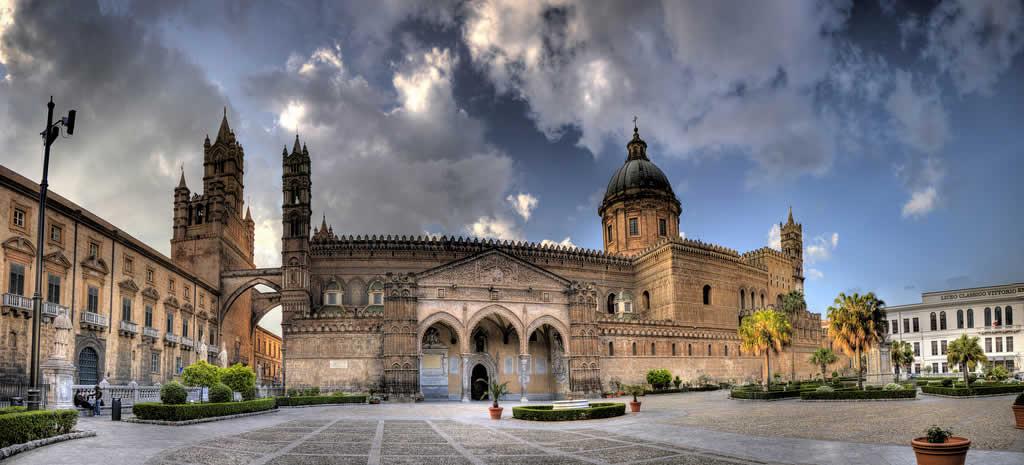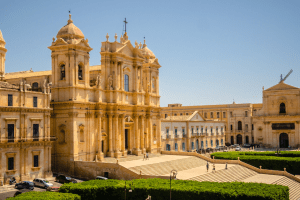- City of Palermo
City of Palermo

Palermo - Palermo is located on the northwestern coast of the island, with about 655,875 inhabitants, it is the capital of the region and includes 82 municipalities. The town overlooks the bay of the Mediterranean Sea, between Monte Pellegrino and Capo Zafferano. The Palermo territory covers approximately 5000 km. It includes various kinds of aspects: the one closely linked to the history and archeology, and archaeological sites, necropolis. The natural aspect, including Parks and Nature Reserves Aim: the Madonie Regional Park; the Natural Monte Pellegrino Reserve, the Natural Island of the Females Reserve, the Natural Reserve Ficuzza Wood, Rocca Busambra, Cappelliere Wood and Gorgo del Drago. The appearance on the coast, and the sea, the beaches and spectacular cliffs and extraordinarily beautiful coves. Palermo is a metropolitan city, large business center and trade thanks to its well equipped Porto. The traffic flow is not only linked to the presence of the port, but also the Airport Falcone and Borsellino, which favors the presence of thousands of visitors who come to Palermo for business or pleasure, and they find to welcome a chaotic city but also home to culture, traditions, entertainment and excellent gastronomy. Palermo is home to prestigious universities, large shopping centers, parks and public gardens, luxury shops. Palermo, as well as being the capital of taste, with typical dishes and foods with unique flavors passed down in history, it is also a milestone in the traveling path of the best wines of Sicily.
The main monuments - Starting from Independence Square, you can visit the charming Norman Palace, the seat of the Sicilian Regional Assembly. Inside, there is the famous Palatine Chapel, a three-aisled basilica dedicated to Saints Peter and Paul, built in 1130 at the behest of Roger II and enriched with beautiful mosaics. To visit the Royal Palace and the Chapel, one can turn to the Federico II Foundation. Not far from Independence Square is the Church of St. John of the Hermits, one of the greatest medieval buildings of Palermo, also built by Ruggero II. From Corso Vittorio Emanuele you reach the Cathedral of the Blessed Virgin Mary of the Assumption. The impressive Cathedral is flanked by four towers of the Norman era and it is topped by a dome. To the south it is connected to the Archbishop's Palace with two large pointed arches on which stands the bell tower with the clock. In the right aisle, the first and the second chapel, communicating with each other, maintain the imperial and royal tombs of Norman, including Roger II, Henry VI of Swabia, Costanza d'Altavilla and Frederick II of Swabia, all in impressive sarcophagi porphyry. Continuing the way you can visit the Church of the S.S. Salvatore, the Church of San Giuseppe dei Teatini and the Church of St. Matthew. This leads to an octagonal square, Piazza Vigliena, at the Quattro Canti, built in the Spanish era (1608-1620). About the decorations of each Canto, on the lower level there are the fountains that represent the rivers of the ancient city Oreto, Kemonia, Pannaria, Papireto; in order follow the allegories of the four seasons represented by Aeolus, Venus, Ceres and Bacchus; the next order, houses the statues of Charles V, Philip II, Philip III and Philip IV; finally, in the higher, the four consecrated Palermo, Agata, Nymph, Olive and Cristina, patron saint of the city before the advent of Santa Rosalia in 1624. The Via Maqueda, just after the Quattro Canti, opens on Piazza Pretoria, also known as the square of Shame, the town hall. The square presents itself to visitors with a wonderful rich fountain of mythological statues. The name of Shame Square is linked to the nakedness of these sculptures. Continuing along Via Maqueda you can admire Palazzo Comitini, seat of the Province. To the south east of Corso Vittorio Emanuele, you come to one of the oldest in the city, known as the Kalsa, cultural and intellectual center of Palermo. Towards Piazza Kalsa meet two monuments in Baroque style, the Church of Santa Teresa and the Church of Santa Maria della Pietà. While the Gothic style is represented by the Church of Santa Maria Nuova and the Church of St. Francis of Assisi, located in the homonymous square. Continuing towards Piazza Marina, are the Giardino Garibaldi and the Marionette Theatre. In the square ithere s the Palazzo Steri, which was founded in 1300 as a fortified residence of Chiaramonte. Continuing along Via Alloro you will find two splendid monuments, Abatellis Palace which houses the Regional Gallery of Sicily, with the most beautiful sculptures of Gagini and Laurana and the Palazzo Gangi, where Visconti shot the ballroom scene in The Leopard. Near Piazza Magione there is the Literary Park of the "Leopard", dedicated to Giuseppe Tomasi di Lampedusa, while in Via Lincoln, you can visit Villa Giulia and the Botanic Gardens. Along Via Roma we come to the famous historical market of "Vucciria" (the term means confusion in Sicilian dialect), which together with other called Ballarò, Capo, Flea Market, constituting an icon of the city. Corso Calatafimi is the most splendid illustration of Arab rule, namely the Zisa Castle, built in 1154, during the reign of William I. As you walk around the city, you can not help but recall the Capuchin Monastery of Palermo, located in the homonymous Square, known for its catacombs that preserve corpses, some mummified, others stuffed, about 8,000 people including members of the clergy and the rich bourgeoisie Palermo, died between VXII and nineteenth centuries. One of the little Rosalia Lombardo, two year old died presumably for bronchial infection, it is the most famous mummy preserved in the Capuchin catacombs. The little girl's face appears intact so as to give the impression that little is asleep.
Some of the main theaters of the city are: the Teatro Massimo, Via Verdi, one of the largest theaters in Europe; Politeama Theatre, located in the homonymous Square; Teatro Biondo located in Via Teatro Biondo; Teatro Metropolitan, located in Viale Strasbourg n. 358, Teatro Golden Ente Autonomo Orchestra Sinfonica Siciliana, located in Via Santa earth 60; the Teatro Massimo in Piazza Bellini, 1.
Among the major museums of Palermo, there are: the Civic Gallery of Modern Art E. Restivo, located on the first floor of the Teatro Politeama (1874); the Museum of Art and Archaeology "Ignatius Mormino" website at Villa Zito; the Regional Gallery, located in the fifteenth century Palazzo Abatellis; the Regional Archaeological Museum A. Salinas, visited at Via Bara Olivella; the International Puppet Museum, located in Via Antonio Pasqualino, 5; the Museum of Zisa, set up within the homonymous Arab-Norman castle; the Ethnographic Museum G. Pitre, located in the area of the Favorita Park - Viale Duca degli Abruzzi; the Risorgimento Museum V. E. Orlando site in Piazza San Domenico, 1.
One of the most anticipated events by Palermo, by devotees and visitors is the Feast of Santa Rosalia, known as "u ra fistinu Santuzza. The religious festival is celebrated every year on 14 and 15 August, and September 4, in honor of the patron saint of Palermo, combining tradition, folklore, gastronomy and enhancing the identity of a resource-rich territory.
The history - The city of Palermo was settled as a city-port by the Phoenicians in the 'VIII BC The Phoenicians were followed by the Romans in 254 BC, all of which facilitated a great development of the city, turning it into a thriving municipality. In the middle 'of the fifth century A.D., during the barbarian invasions of Italy and Sicily, Palermo was sacked by the Vandals, occupied by the Ostrogoths and subsequently dominated by the Byzantines (535-831). In that period the city was restored and the island became a province of the Eastern Empire device. During the Arab conquest of Sicily, in '831, Palermo played a role of great prestige in the whole Mediterranean. (At that period are still the mosques present in the city). 1072 marked the Normans of Sicily in the Great Count Roger de Hauteville and his cousin, Robert Guiscard. With Henry VI to the Normans succeeded the Swabians, who had in Frederick II, son of Henry and Constance, the last heir of the Norman dynasty, a sovereign cultured and magnificent. With Federico II, Palermo lived the most prosperous period in its history, boasting the construction of beautiful churches and monuments Chapels (the Kingdom of Federico II dates the construction of the spectacular Palatine Chapel). Under the rule of Charles of Anjou, the power of the kingdom moved from Palermo to Naples. Later, the city became the new capital under the Aragonese until the fifteenth century, where will the Spaniards as viceroy. Charles V of the Hapsburgs of Spain used it as a strategic center of Palermo against the Ottomans. From 1713 to 1734, Palermo came under the domination of the Kingdom of Savoy Victor Amadeus; under the Austrian Hapsburgs; to finally go under the Bourbons with Charles III. In 1860, Giuseppe Garibaldi landed with his thousand volunteers in Marsala, defeated the Bourbon troops and triumphed in Palermo. That year Sicily was annexed to Italy, which will be finally united in 1861. Subsequently Palermo enjoyed a renaissance with the construction of its magnificent theaters, the Politeama and Massimo and to the great influence of the powerful Florio family. A historic day for the city of Palermo is May 15, 1946, the day when the King Umberto II of Savoy, declared the autonomy of the Sicilian Region, which will be governed by a special statute. Palermo will host the seat of the regional parliament at the historic Palace of the Normans.







